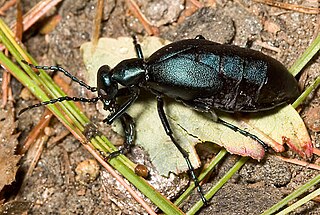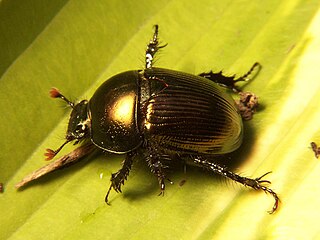
Meloe impressus is a species of blister beetle in the family Meloidae. It is found in North America.
Eucanthus subtropicus is a species of earth-boring scarab beetle in the family Geotrupidae. It is found in North America.

Eucanthus is a genus of earth-boring scarab beetles in the family Geotrupidae. There are about eight described species in Eucanthus.

Symbiotes is a genus of beetles in the family Anamorphidae. There are about five described species in Symbiotes.
Eucanthus lazarus is a species of earth-boring scarab beetle in the family Geotrupidae. It is found in North America.
Aidophus is a genus of aphodiinae dung beetles in the family Scarabaeidae. There are about 12 described species in Aidophus.
Cercyon impressus is a species of water scavenger beetle in the family Hydrophilidae. It is found in Europe & Northern Asia and North America.
Cnopus impressus is a species of ant-like leaf beetle in the family Aderidae. It is found in North America.

Cnopus is a genus of ant-like leaf beetles in the family Aderidae. There are at least four described species in Cnopus.
Trixagus chevrolati is a species of small false click beetle in the family Throscidae. It is found in Central America and North America.
Tohlezkus inexpectus is a species of plate-thigh beetle in the family Eucinetidae. It is found in North America.
Panscopus impressus is a species of broad-nosed weevil in the beetle family Curculionidae. It is found in North America.
Boros unicolor is a species of conifer bark beetle in the family Boridae. It is found in North America.
Scirtes orbiculatus is a species of marsh beetle in the family Scirtidae. It is found in North America.
Elacatis umbrosus is a species of narrow-waisted bark beetle in the family Salpingidae. It is found in North America.

Sphaeriestes is a genus of narrow-waisted bark beetles in the family Salpingidae. There are about 13 described species in Sphaeriestes.
Dacoderus steineri is a species of narrow-waisted bark beetle in the family Salpingidae. It is found in North America.
Loberus impressus is a species of pleasing fungus beetle in the family Erotylidae. It is found in North America.
Saprinus impressus is a species of clown beetle in the family Histeridae. It is found in North America.
Eucanthus greeni is a species of earth-boring scarab beetle in the family Geotrupidae. It is found in North America.







